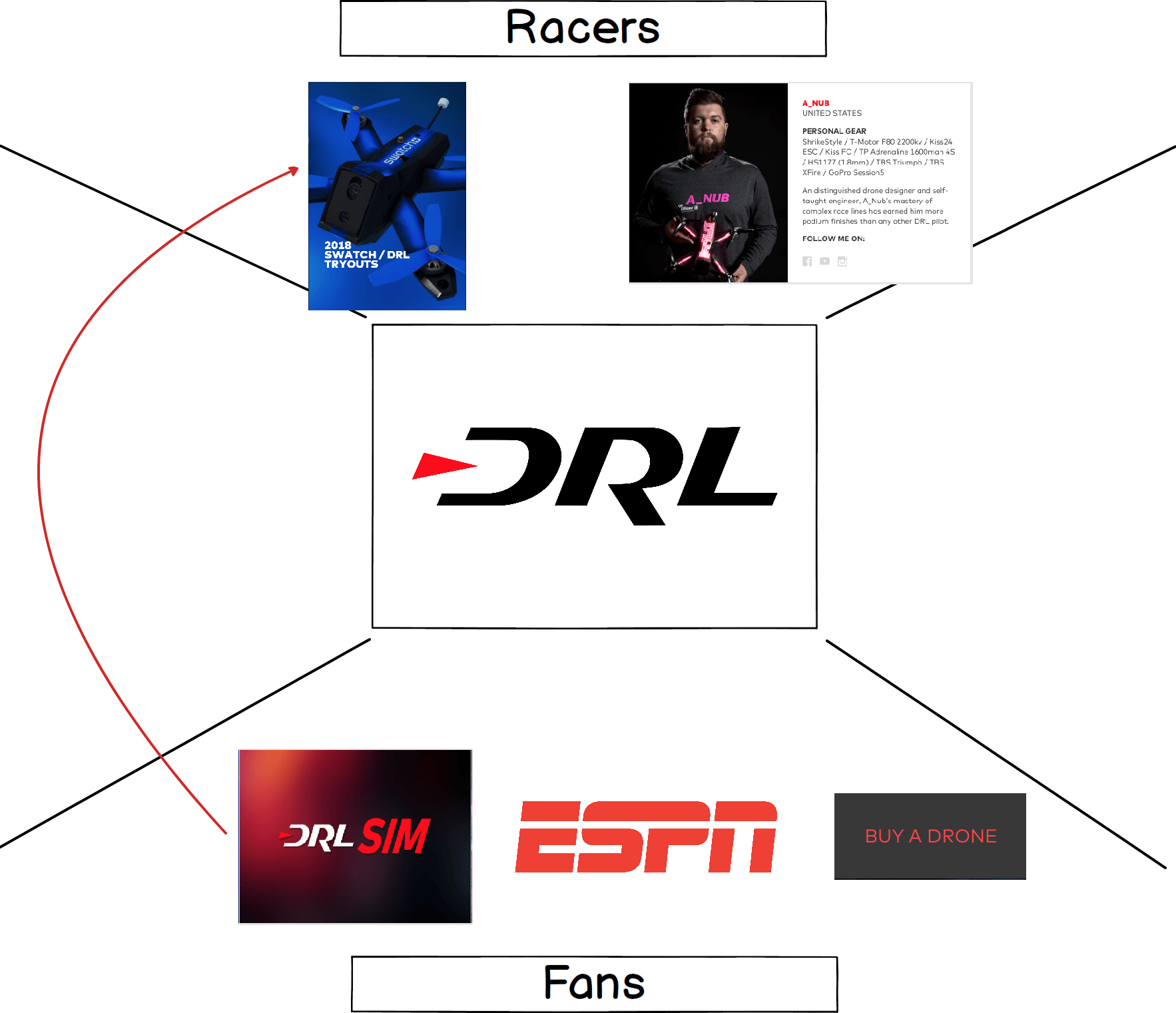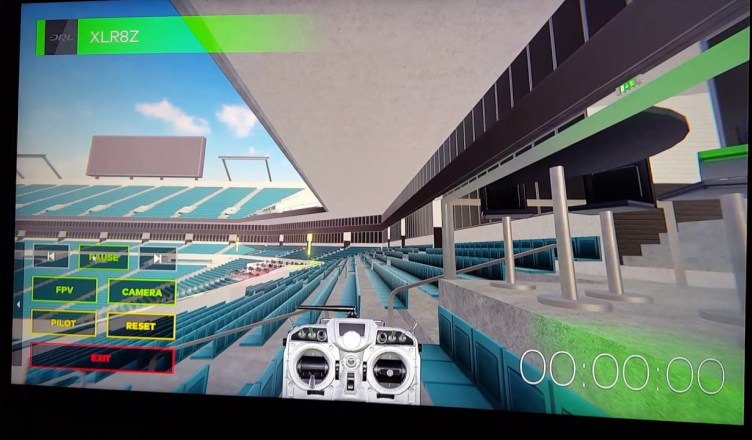Drone Racing League

Drone Racing League pilots put on their VR helmets and enter a first person view of custom built drones that can fly at over 80 mph through stunning courses.
Drone Racing League (DRL) is perhaps as close as humanity has come to the ‘Pod Racing’ seen in Star Wars. Its a fusion of video gaming, virtual reality, and Formula 1 racing. DRL Pilots put on their VR helmets and enter a first person view of custom built drones that can fly at over 80 mph. These Pilots race through breathtaking courses in stadiums, abandoned warehouses, and buildings. The capabilities of these drones allow the league to produce stunning media content unlike anything seen before. Here is a video of a race through the Miami Dolphins Football Stadium:
Founded in 2015 by HBS alumni Nicholas Horbaczewski, DRL has signed partnerships with ESPN, Fox Sports, Swatch, and the U.S. Air Force (1). The company has raised $21M in funding from strategic investors and VC funds (2). DRL is leveraging a multi-faceted strategy of media, content, sponsorships, and technology to scale up their platform business. And fans are watching. “The league, which airs on big networks like ESPN and Sky, says it reached an audience of more than 30 million viewers during its inaugural season last year” (3). The league has ~ 750,000 Facebook, 85,000 Instagram, and 33,000 Twitter followers.
First, a little about the market. According to Business Insider, “Consumer drones are drones purchased by individuals for noncommercial and nonprofessional purposes. BI Intelligence expects consumer drone shipments to hit 29 million in 2021, which would indicate a CAGR of 31.3%.” (4).
DRL is capitalizing on the popularity of drones, newfound interest in virtual reality, and the emergence of eSports as high growth market opportunities. They have implemented a unique strategy to grow their platform:
As depicted above, the DRL platform has two sides: one is the consumers of the content and the other are the Racers. The monetization strategy of DRL is similar to other sports industries. Viewers tune in to watch their favorite racers compete in high stake competitions for prize money, and advertisers pay to promote their brands to these fans. Secondly, DRL internally builds its own high speed drones, and sells drones through their website (they also sell gear).
DRL’s strategy to fuel scaling its platform business is fascinating. The high-fidelity custom drones built by DRL for these races are expensive (and currently unavailable to the general public). Secondly, the types of courses built by DRL for these races are not accessible to novices. Thirdly, having VR glasses that link to a first person view of the drone is another expensive requirement. This would seemingly pose as a major barrier to growing a community of dedicated fans because they cannot easily participate. However, DRL has turned this seeming challenge into a scaling opportunity by developing a course simulation video game. On DRL’s website, anyone can download a free simulator that lets users practice and fly drones on replicas of the tracks the pros are racing in the league:
By doing this, DRL is building competitive competencies in drone innovation / manufacturing (their high speed drones are proprietary), video game development, and sports/media entertainment. They are also fueling their own platform. As shown in the diagram above, racers in the simulator can participate in online competitions. Winners of these competitions are invited to compete in the real league and have an opportunity to become professional racers for the league. With the DRL simulator, the user only needs a video game controller to become an avid racer and have an opportunity to refine their skills and (maybe) go pro.
Of course, only time will tell if Drone Racing will be a major sport of the future. DRL is a frontrunner in this opportunity and I personally look forward to seeing how fast they can fly.
(1) The Drone Racing League. (2018). Homepage 2.0 – The Drone Racing League. [online] Available at: https://thedroneracingleague.com [Accessed 2 Mar. 2018].
(2) Crunchbase. (2018). Drone Racing League | Crunchbase. [online] Available at: https://www.crunchbase.com/organization/droneracingleague#section-overview [Accessed 2 Mar. 2018].
(3) The Verge. (2018). Drone Racing League returns to ESPN with faster, more crashable aircraft. [online] Available at: https://www.theverge.com/2017/4/6/15196694/drone-racing-league-drl3-new-quadcopter-2017-season [Accessed 2 Mar. 2018].
(4) Meola, A. (2018). Drone market shows positive outlook with strong industry growth and trends. [online] Business Insider. Available at: http://www.businessinsider.com/drone-industry-analysis-market-trends-growth-forecasts-2017-7 [Accessed 2 Mar. 2018].





Very interesting post Jesse! The strategy around providing a video game simulation to pull people into the platform play is really interesting, especially since this is a non-traditional activity (i.e., relative to football, baseball few people have grown up doing it). It would be interesting to see how these participative marketing approaches have worked out for other platforms (I’d hypothesize they could create pretty sticky users). Also interesting that the simlulators become another way to deliver ad content and monetize users. I’m curious about perspectives on the terminal scale of the platform — could it be as big as football/ baseball one day? Star Wars suggests maybe!
Given drone racing is still quite niche, I wonder about the timing of staying a closed platform vs. opening to 3rd party developers. The level of sophistication and cost seems like a continued barrier in the long run, especially when demand for races increases. While I agree that the strategy now should focus on controlling product dev and managing the brand image and UX quality, with a game type that could fit so many genres, perhaps going to the crowd like Google did with Android might be better than plodding along like Apple and the iPhone. Furthermore, their current partnerships have been mostly with distributors and channels. What about on the content side with Ubisoft, Blizzard, Valve, etc.?
I wonder if the initial success that the league has found is the novelty of the “sport” plus the help of TV networks pushing the league in the hope of creating new, must-see live content. Given the barriers to entry you laid out for the layman to participate and trial the sport, it seems unlikely that the growth can be sustained. Thus far, all of the demand seems to have been pushed from the league and networks, and less pulled from viewers. If I was DRL, I would immediately start showcasing the drone product in cities all over the country so that viewers could try the drones and build an emotional connection to the league.
Awesome post Jesse! Loved the shout-out to pod-racing. Interesting network diagram – had not considered matching racers and fans. The discussion mentioned advertisers as well; I wonder what a diagram would look like if we tried to incorporate advertisers, other drone manufacturers, and sports media outlets – it might have too many dimensions or look too messy! Were the DRL’s strategy folks to construct multiple such diagrams, they might discover innovative ways to continue growing and create and capture value creatively. Thanks again for a great read!
Amazing post, amazing promo video. Has there been any discussion to expanding the product in a more democratic way by allowing consumers to create their own content? Racers with an AR set could create custom courses for one another that would only require a large field rather than professional equipment and cameras. Racers could ‘ghost race’ against professionals on the best courses. Worldwide leaderboards could keep racers engaged long-term. I can’t wait.
Drone racing also opens a very interesting hardware platform, which is relatively rare compared to software platforms. There are many open-source designs as well as drone racing communities that create detailed specifications and parts lists to assist drone racers in building customer racing drones. I agree with your point about prices being inaccessible to most users, but that is at least in part due to the technology being new to market; prices have decreased substantially in the past 5 years and will continue to decrease. I am very excited about drones as a hardware platform because they are somewhat a form of “adult” Legos. You assemble various parts and end up with something functional and cool that you can customize to be your own. I am hopeful that this capability will extend into high school and youth robotics programs and get kids and young adults more excited about building things and hopefully entering careers in engineering.
This is super cool. I do wonder, though, how realistic DRL’s estimates are of future consumer demand for competitive drone racing. Why pay to rent stadiums, set physical courses, and invest in recording/streaming tech when this could all be rendered digitally? I think the young market DRL is going for will instead be overwhelmingly dominated by e-sports leagues like MLG and services like Twitch. Today, e-sports fans seem more interested in MOBA, FPS, and Battle Royale games than the racing genre, but if a killer competitive racing game emerges, there will no doubt be a mass audience for it.